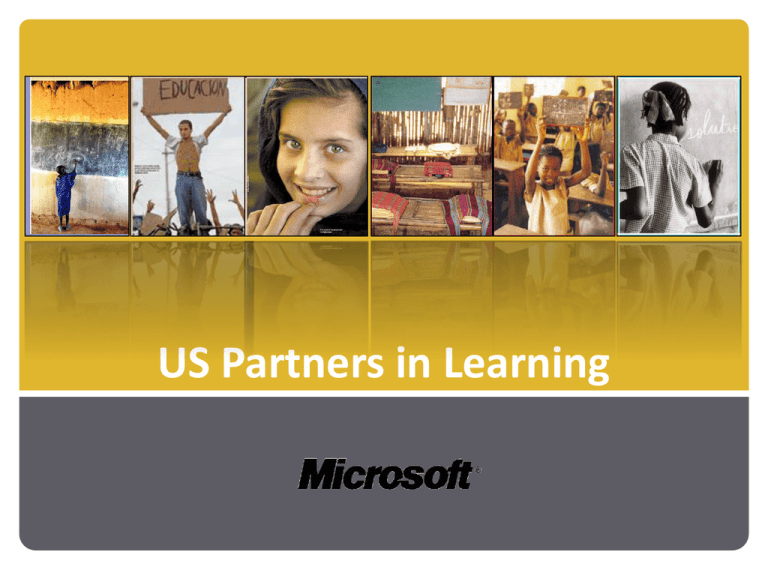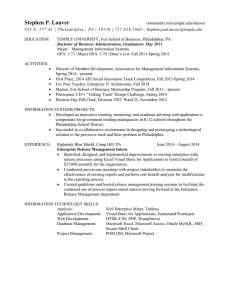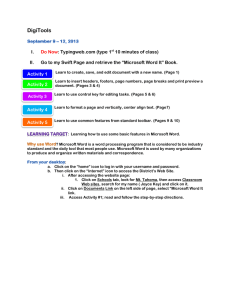
US Partners in Learning
i m a g i n e …..
Providence (RI) WJAR –
Pre-Schooler Selected For Jury Duty
Wed Feb 7, 2007 6:25 PM EST
A n d y e t , e v e r y d a y, t h r o u g h o u t o u r
country…
To d a y … o u r q u e s t i o n m u s t b e …
“How do we create Artists of Learning ”
“Overcoming the Noise….”
Lack of Parental Engagement.. Budget Cuts.. Federal
Regulations.. Poor Succession Planning..Pre-Service
Instruction.. Socio-economic Disparity.. Bureaucratic
Systems..Transitory Leadership.. Insufficient Salary
Structures.. Community Disengagement.. “District Office”
Engagement.. Capacity Building.. Unrealistic Yardsticks for
Success.. Poor Physical Environments..
What will be our legacy…
• Bertelsmann Foundation Report: The Impact of Media and Technology in
Schools
– 2 Groups
– Content Area: Civil War
– One Group taught using Sage on the Stage methodology
– One Group taught using innovative applications of technology and
project-based instructional models
• End of the Study, both groups given identical teacher-constructed tests of
their knowledge of the Civil War.
Question: Which group did better?
Answer…
No significant test
differences were found
However… One Year Later
– Students in the traditional group could recall almost nothing about the
historical content
– Students in the traditional group defined history as: “the record of
the facts of the past”
– Students in the digital group “displayed elaborate concepts and ideas
that they had extended to other areas of history”
– Students in the digital group defined history as:
“a process of interpreting the past from different perspectives”
We are asking the wrong questions
• Does technology have a direct correlation on
student achievement?
• Why haven’t we discovered the Silver Bullet?
• What is the School of the Future Blueprint?
However… There is hope all around
Whiteboards
Wireless
PDAs
Carts
Real-time
Assessment
Laptops
Portals
Distance
Technology
is
Learning
OneNote
email issue
not the
Labs
Robotics
Smartcards
Wireless
Projectors
Flexible
Space
T1
Virtual
Classrooms
Instructional
Management
Solutions
WWW2
Distributed
T3
Media Windows Server 2003
Tablets
IM
Speech Recognition
Redefining the
norm is…
Our Example
Philadelphia School of the Future
What are we trying to create?
An environment where learning is:
• Continuous
• Relevant
• Adaptive
Philadelphia Context
• Grade 9 – 12 Public High School with 750 Students opening Sept. 2006
• Neighborhood High School with comprehensive curriculum, not special admit
• 3 Year project funded by the School District of Philadelphia with a standard
budget allocation
• Microsoft’s contribution primarily human capital, partnership development
support and MCS resourcing and is part of our US Partners in Learning
portfolio
• New construction in West Philadelphia (163K Sq. Ft.)
• Best practices and outcomes to be leveraged worldwide.
Building not required.
• Resources available at www.microsoft.com/education/sof
Innovation Orchestration…
Be
Comfortable
Not Knowing
Language is
Paramount
Learning
First…
Technology
Later
Lack of
Process
Impedes
Success
Identify the
Questions and
Answers Will
Come
Innovation Orchestration...
• What are you
trying to create?
Creating Common
Vision
• What process will
discipline your
effort?
Disciplined
Methodology
• Who are you
creating it for?
• How will your
organize your
work?
Know Thy
Customer
Define Scope
• What factors are
critical for
success?
• What assets are
required to
support your
success factors?
Establish Common
Language
Remember…
Less is More
What is Critical for Success?
19
Success Factor 1:
Involved and connected learning community
Success Factor 2:
Proficient and inviting curriculum-driven setting
Success Factor 3:
Flexible and sustainable learning environment
Success Factor 4:
Cross-curriculum integration of research and development
Success Factor 5:
Professional Leadership
Entrance
School of the Future
www.microsoft.com/education/sof
•
Michigan first state in the nation to
require all students to take an online
course or have an online learning
experience in order to graduate from
high school.
•
The new online course titled
CareerForward® empowers students
to take charge of their own career path
while meeting the new state
requirement for online learning.
•
Designed primarily for ninth graders, it
is relevant for any grade in middle or
high school and is available to all
Michigan K-12 students and schools.
Here’s what we know…
•
1/3 of all public high school students fail to graduate from public school with their class
•
70% of respondents said they were not motivated or inspired to work hard. 2/3 would have
worked harder if it was demanded of them.
•
59 – 65% of respondents missed classed often the year prior to dropping out.
•
This generation will have, on average…. 19 JOBS!
•
81% of students surveyed believed there should be more opportunities for real-world and
experiential learning
•
Today’s average US student has 4 – 5 email addresses
•
26% of US students access a foreign news service
•
The fastest growing segment of computer users today in the US is 5 – 7 year olds.
MOTIVE
If you remember 1 thing…
• Motivations
• Obstacles
• Trends
• Interests
• Values
• Environment
Next Steps…
1. Support of alternative instructional experiences and assessments
2. Continue to demand academic rigor
3. Provide un-encumbered access to expertise
4. Support the acquisition of 21st Century tools and resources
5. Transformation of “teacher” to “instructional team”
6. Remove the current of inertia… Just imagine if innovation was “swimming
downstream”
Have Hope…
© 2005 Microsoft Corporation. All rights reserved.
This presentation is for informational purposes only. Microsoft makes no warranties, express or implied, in this summary.






